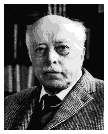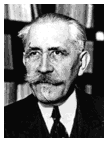Founders and pioneers
The patrons
When the French and German governments were seeking a name for the Institute in the 1960s, they decided to honour French and German scientists distinguished for their contributions not only to science but to society in general. Their choice fell upon France's Paul Langevin and Germany's Max von Laue.

Max von Laue 1879-1960
The German physicist Max von Laue was awarded the Nobel Prize in 1914 for demonstrating the diffraction of x-rays by crystals. His discovery led to the first measurements of wavelength, as well as demonstrating the organisation of atoms in a crystal and the wave nature of x-rays. His work is at the basis of the analytical methodology employed in all measurements based on the diffraction of x-rays, synchrotron light, electrons and neutrons.
Max von Laue was a strong objecter to National Socialism and played a leading role in re-establishing and organising German science after World War II.

Paul Langevin 1879-1946
Paul Langevin was an eminent physicist in a pioneering French team of atomic researchers which included Pierre and Marie Curie. He was a specialist in magnetism, ultrasonics and relativity, and devoted forty years of his life to his responsibilities as Director of the Paris École de Physique et Chimie. His study of how rapid neutrons are slowed - or "moderated" - in their collision with atoms was an invaluable contribution to the design of research reactors.
Paul Langevin was a declared anti-fascist and was president from 1944 to 1946 of the French Ligue des droits de l'homme (human rights league).
The founders
The ILL owes its existence to the mutual friendship and esteem of Louis Néel and Heinz Maier-Leibnitz. They were both determined to bring post-war France and Germany together through the creation of a major centre for neutron research, and devoted their efforts to pleading this cause - most successfully - with their respective governments.

Louis Néel 1904-2000
Louis Néel was a specialist in magnetism and won the Nobel Prize in 1970 for his discovery of the antiferromagnetic/ferromagnetic double lattice, which is at the origin of all magnetic phenomena other than classical ferromagnetism. He was a scientist of personality and influence and played a major role in the birth and successful development of research in Grenoble. With other French and German scientists, he made a major contribution to the creation of the Institut Laue-Langevin.

Heinz Maier-Leibnitz 1911-2000
Heinz Maier-Leibnitz founded Germany's first research reactor near Munich and is recognised as the father of neutron research in Germany. His experience and expertise in instrumental techniques, and in neutron optics in particular, paved the way for the avant-garde development of ILL's early installations. He was the first Director of the Institute from 1967 to 1972.
You will find a tribute to Prof. Maier-Leibnitz here, first published in a 2001 supplement to ILL News.
The pioneers
Ever since its early days, the ILL has attracted scientists of renown, drawn to the Institute by the quality of its research and its very specific technical, scientific and cultural environment. Amongst these pioneering shapers of the ILL's future we would like to cite the following:

Erwin-Félix Lewy-Bertaut 1913-2003
Erwin Lewy was the son of a German rabbi. He fled Nazi Germany and came to France to pursue his university studies. Under a new identity as Félix Bertaut, he studied chemistry with Alfred Kastler in Bordeaux and then crystallography in Paris. In 1943 Louis Néel invited him to Grenoble, where he was to remain for most of his scientific career. "Bertaut" produced a thesis on the study of magnetism using x-rays and then discovered the magic of neutrons at Brookhaven. With this he went on to define a host of different magnetic structures. He was brilliant as both a theoretician and experimentalist - one of the major figures of neutron science, in Grenoble and beyond, and one of the ILL's most fervent supporters.
Read more about E.-F. Lewy-Bertaut in this IOP Science article, by G. Ferey and JL Hodeau

Rudolf Mößbauer 1929-2011
Rudolf Mößbauer was a German physicist who, at the age of only 32, was awarded the Nobel Prize in Physics for his work on the resonant and recoil-free absorption and emission of gamma rays in solids. He had just finished his PhD thesis under the supervision of Heinz Maier-Leibnitz at the Technische Hochschule in Munich. Rudolf Mößbauer was later to succeed his mentor Maier-Leibnitz as Director of the ILL from 1972-1977.
He spent much of his life as a professor at the Technical University of Munich (TUM) where he was finally to dedicate his time to neutrinos. His "Mößbauer spectroscopy" remains widely used for characterising materials, and has even been employed by NASA on the planet Mars.

Walter Hälg 1917-2011
Walter Hälg is regarded as the founder of neutron scattering in Switzerland. After his PhD at the University of Basel, he worked for Brown Bovery & Cie (BBC) in Baden, developing DIORIT, Switzerland's heavy water reactor. He contributed valuable ideas to the current Swiss spallation source as a full professor for reactor technology at ETH Zürich. He gave his name to the "Walter Hälg Prize" awarded every two years by the European Neutron Scattering Association.

Norman Foster Ramsey 1915-2011
The Harvard professor Norman Foster Ramsey was the co-laureate of the Nobel Prize in Physics in 1989 for the separated oscillatory field method and its applications (in atomic clocks, for example). He was an appointed delegate to international organisations such as NATO and the United States Atomic Energy Commission. Norman Ramsey was instrumental in the establishment of the Brookhaven National Laboratory on Long Island. His research - focused on finding the electric dipole moment in the neutron - often brought him to the ILL for neutron measurements.

Bernard Jacrot 1926-2016
Bernard Jacrot is considered among the founding fathers of French neutron scattering. He was part of the group that first proposed the ILL at the Geneva conference in 1964, and he was the first French Associate Director of ILL from 1967 to 1973.
Bernard Jacrot played an important role in the beginnings of neutron scattering in condensed matter physics in the 1950s, in international scientific collaborations in the 60s, and in structural biology in the 70s and 80s. His scientific legacy is very much alive through the interdisciplinary applications of neutron scattering that he pioneered. After his term of office as the ILL French Director, he returned to ILL as Senior Scientist for biology, to introduce the interdisciplinary physics/biology approach that also paved the way for neutron scattering in soft condensed matter.
In 1980, he was awarded the Felix Robin prize of the French Physical Society for his lifetime achievement in physics. And in Neutrons for Science, he wrote the history of ILL.

Anton Oed 1933-2018
Anton Oed, a passionate inventor and a source of inspiration for many of us today, passed away on 30 September 2018. His introduction of micro-strip gas chambers (MSGCs) at the Institut Laue-Langevin (ILL) in 1988 was a decisive breakthrough in the field of radiation detectors. It demonstrated a significant gain in spatial resolution and counting rate, and the invention immediately stimulated the development of a new class of micro-pattern gas detectors (MPGDs). [more].

Helmut Rauch 1939 - 2019
Professor Rauch was one of ILL's most prominent scientific users and CRG scientists, most famous for his development of a perfect-crystal neutron interferometer. Neutron interferometry has led to a series of breathtaking quantum physical experiments and still continues to do so.
Helmut was Director of the Atominstitut of the Vienna University of Technology for more than 3 decades. He was member of ILL's Scientific Council and also did a lot to support Austria's Scientific Membership. [more]
